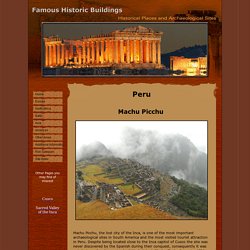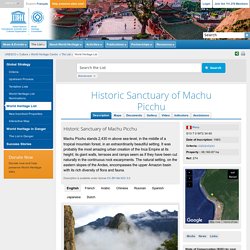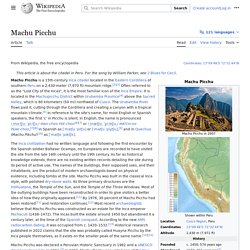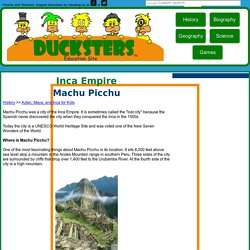

Machu picchu. Machu Picchu, Peru. Peru Machu Picchu Machu Picchu, the lost city of the Inca, is one of the most important archaeological sites in South America and the most visited tourist attraction in Peru.

Despite being located close to the Inca capitol of Cusco the site was never discovered by the Spanish during their conquest, consequently it was not destroyed and remained relatively intact. Machu Picchu (meaning 'Old Peak' in the Quechua language) refers to the mountain that overlooks the city, its Inca name is not known. Believed to have been built by Pachacuti, the ninth Sapa Inca (1438 - 1471 AD), the true purpose of Machu Picchu has never been conclusively determined although it is believed to have been a retreat for the Inca chief and his elite or a secret ceremonial city.
Spread over approximately 5 square miles, Machu Picchu housed a population of around 750 to 1200 people. Machu Picchu: Facts & History. Machu Picchu - Facts & Summary. In the summer of 1911 the American archaeologist Hiram Bingham arrived in Peru with a small team of explorers hoping to find Vilcabamba, the last Inca stronghold to fall to the Spanish.

Traveling on foot and by mule, Bingham and his team made their way from Cuzco into the Urubamba Valley, where a local farmer told them of some ruins located at the top of a nearby mountain. The farmer called the mountain Machu Picchu, which translates to “old peak” in the native Quechua language. On July 24, after a tough climb to the mountain’s ridge in cold and drizzly weather, Bingham met a small group of peasants who showed him the rest of the way. Led by an 11-year-old boy, Bingham got his first glimpse of the intricate network of stone terraces marking the entrance to Machu Picchu.
Although he is credited with making Machu Picchu known to the world—indeed, the highway tour buses use to reach it bears his name—it is not certain that Bingham was the first outsider to visit it. Fun Machu Picchu Facts for Kids - Interesting Trivia & Information. Machu Picchu was build at the height of the Inca Empire around 1450 but abandoned just over a century later in 1572 after the Spanish arrival in Peru.

Archaeologists believe Machu Picchu was constructed for use as a Royal Estate. Historic Sanctuary of Machu Picchu. Historic Sanctuary of Machu Picchu Machu Picchu stands 2,430 m above sea-level, in the middle of a tropical mountain forest, in an extraordinarily beautiful setting.

It was probably the most amazing urban creation of the Inca Empire at its height; its giant walls, terraces and ramps seem as if they have been cut naturally in the continuous rock escarpments. The natural setting, on the eastern slopes of the Andes, encompasses the upper Amazon basin with its rich diversity of flora and fauna. Description is available under license CC-BY-SA IGO 3.0 Sanctuaire historique de Machu Picchu À 2 430 m d'altitude, dans un site montagneux d'une extraordinaire beauté, au milieu d'une forêt tropicale, Machu Picchu a probablement été la création urbaine la plus stupéfiante de l'Empire inca à son apogée : murailles, terrasses et rampes gigantesques sculptent les escarpements rocheux dont elles paraissent le prolongement.
معابد ماشو بيتشو التاريخيّة 马丘比丘古神庙 马丘比丘古庙位于一座非常美丽的高山上,海拔2430 米,为热带丛林所包围。 マチュ・ピチュの歴史保護区. Machu Picchu. Machu Picchu (English: /ˈmɑːtʃuː ˈpiːktʃuː/[1][2][3][4][5][6] or /ˈpiːtʃuː/,[3][7][8] Spanish: [ˈmatʃu ˈpi(k)tʃu];[9] Quechua: Machu Pikchu[10] [ˈmatʃʊ ˈpɪktʃʊ]) is a 15th-century Inca citadel, located in the Eastern Cordillera of southern Peru, on a 2,430 metres (7,970 ft) mountain ridge.[11][12] It is located in the Cusco Region, Urubamba Province, Machupicchu District,[13] above the Sacred Valley, which is 80 kilometres (50 mi) northwest of Cuzco and through which the Urubamba River flows, cutting through the Cordillera and creating a canyon with a tropical mountain climate.[14] Most archaeologists believe that Machu Picchu was constructed as an estate for the Inca emperor Pachacuti (1438–1472).

Often mistakenly referred to as the "Lost City of the Incas" (a title more accurately applied to Vilcabamba), it is the most familiar icon of Inca civilization. Inca Empire for Kids: Machu Picchu. History >> Aztec, Maya, and Inca for Kids.

Machu Picchu. By Kelly HearnJason Golomb On the morning of July 24, 1911, an enterprising lecturer-explorer from Yale University set off in a cold drizzle to investigate rumors of ancient Inca ruins in Peru.

The explorer chopped his way through thick jungle, crawled across a "bridge" of slender logs bound together with vines, and crept through underbrush hiding venomous fer-de-lance pit vipers. Two hours into the hike, the explorer and his two escorts came across a grass-covered hut. A pair of local farmers walked them a short way before handing them over to a small boy. Machu Picchu.